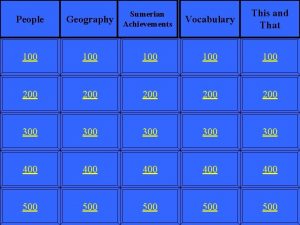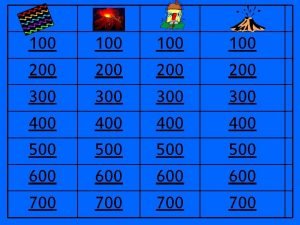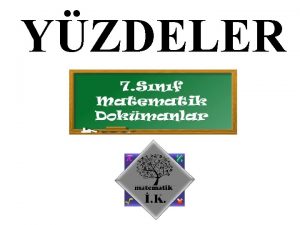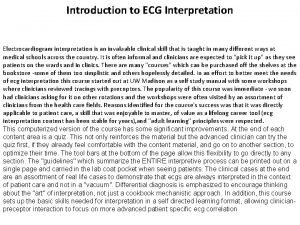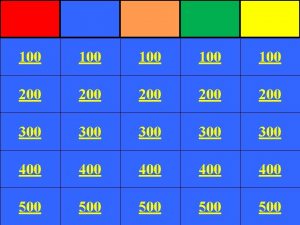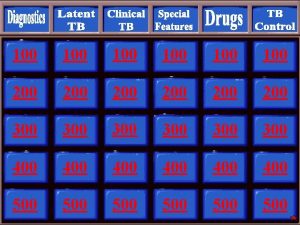Jeopardy 100 100 100 200 200 200 300
































- Slides: 32

Jeopardy!

100 100 100 200 200 200 300 300 300 400 400 400 500 500 500

Levels of organization 100 § Which level of organization is considered the most complex? § Human organism Return

Levels of organization -200 § At what level of organization can life be sustained? § The Cell § Return

Levels of organization -300 § Atoms combine to form molecules. Give 2 examples of molecules. § Water, carbon dioxide, glucose, etc… Return

Levels of organization -400 § List 4 organelles that are found in a human body cell. § Nucleus, ribosome, golgi body, mitochondria, lysosome, etc… Return

Levels of organization -500 § There are 9 levels of organization. They are arranged from simplest to most complex. Name the 9 levels from simple to complex. § Atom, molecule, macromolecule, organelle, cell, tissue, organ system, & organism Return

Directional terms -100 § Explain and demonstrate correct anatomical position. § Standing erect, face forward, palms forward § Return

Directional terms -200 § What is the anatomical term for the “front” side of the heart. § Ventral, anterior Return

Directional terms -300 § What body structure is located medial to the ears. § The nose. Return

Directional terms -400 § The directional terms proximal and distal are in reference to the _____. (body part) AND what defines each term? § Trunk: proximal/close ; distal/farther Return

DAILY DOUBLE 500 * 2 § Sagittal: divides § Explain the body into left differences of a and right portions. § Frontal: anterior sagittal cut, and posterior frontal cut, and portions transverse cut. § Transverse: superior and inferior portions? § Return

Body cavities & regions -100 § The head, neck, and abdomen would be in this portion of the body. § Axial Return

Body cavities & regions -200 § Which of the following is an example of an upper abdominal region: Right Iliac, hypogastric, or Left Hypochondriac. § Left Hypochondriac § Return

Body cavities & regions -300 § The thoracic portion of the ventral abdominal cavity is separated from the abdominopelvic portion by a muscle called the ______. § diaphragm Return

Body cavities & regions - 400 § What organ is not found in the pelvic cavity: bladder, stomach, rectum, colon § stomach § Return

Body cavities & regions -500 § Which of the following structures does not lie within the mediastinum: aorta, liver, esophagus, trachea. § liver Return

Landmark regions -100 § If a doctor was referring to the wrist area, the landmark name would be _____. § carpal § Return

Landmark regions -200 § When you are applying deodorant, what landmark region are you applying it to? § Axillary § Return

Landmark regions -300 § When babies get diaper rash, ointment is applied to this landmark area. § Perineal Return

Landmark regions -400 § Athletes often tear muscles during sports activities because of improper stretching. A hurdle jumper may tear muscles in this landmark region if they didn’t warm-up. § Inguinal § Return

Landmark regions -500 § The buttocks are often used as intramuscular injection sites. This region can be called ______. § Gluteal Return

Membranes-100 § This membrane type covers organs. § Visceral membrane § Return

Membranes -200 § This membrane type lines body cavities. § Parietal membrane Return

Membranes - 300 § An emergency room patient had a superficial stab wound which injured the visceral and parietal peritoneum. In what region was the injury located? § abdomen § Return

Membranes -400 § Serous fluid in the pleural cavity would be found between membranes surrounding the _____. § lungs § Return

DAILY DOUBLE - 500 * 2 § The membrane that covers the heart is called the _______. § The membrane that lines the cavity is called the_____. § Visceral pericardium § Parietal pericardium Return

Misc. -100 § An anatomist would study _______ whereas a physiologist would study ______. § Structure; function § Return

Misc -200 § The bodies ability to respond to changes in the environment and to maintain consistency in the internal environment is called: § homeostasis Return

Misc -300 § The study of tissues is called ____, whereas the study of cells is called _____. § Histology; cytology § Return

Misc -400 § A synonym for medial is ______. § midline Return

Misc. -500 § If your reference point is “nearest the trunk of the body” rather than “farthest from the trunk of the body, ” where does the elbow lie in relation to the wrist? Anterior, posterior, distal, or proximal. § Proximal Return
 200+200+300
200+200+300 300 + 200 + 200
300 + 200 + 200 200+100+300
200+100+300 300+300+400
300+300+400 100 100 100 100 100
100 100 100 100 100 200 300 300
200 300 300 200+200+100+100
200+200+100+100 200 + 200 + 300
200 + 200 + 300 100+200+300+400
100+200+300+400 Now testojack 200 reviews
Now testojack 200 reviews 100 200 300 400 500
100 200 300 400 500 100 200 300 400
100 200 300 400 100 200 300 400
100 200 300 400 100 200 300 400 500
100 200 300 400 500 100 200 300 400 500
100 200 300 400 500 300+300+400
300+300+400 300 300 400
300 300 400 300+300+400
300+300+400 300+300+400
300+300+400 All factors of 88
All factors of 88 300+300+400
300+300+400 300+300+400
300+300+400 400 + 300 + 300
400 + 300 + 300 100+100=200
100+100=200 Is 101 a prime number
Is 101 a prime number What's 200 * 300
What's 200 * 300 Greece 300 bc
Greece 300 bc 200 300 400
200 300 400 60'ın 10'u kaçtır
60'ın 10'u kaçtır 200-300 lexile books
200-300 lexile books 300 150 100 ekg
300 150 100 ekg The conduction system
The conduction system 600+800+800
600+800+800






